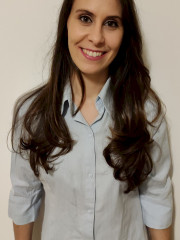
I. Casado Losada (Vienna, AT)
Medical University of Vienna Orthopedics and Trauma SurgeryPresenter Of 1 Presentation
P057 - Laser-Engraving Auricular Cartilage Scaffolds to Improve Scaffold Recellularization
Abstract
Purpose
Recellularization still remains one of the main challenges to the use of decellularized cartilage materials for articular cartilage regeneration. With this objective, our group has previously developed two different strategies: i) laser-engraving of articular cartilage scaffolds, and ii) enzymatically treating auricular cartilage scaffolds. The current study aimed to combine the strength of both approaches by laser engraving auricular cartilage to 1) assess cellular infiltration and 2) determine the chondrogenic potential of those scaffolds for focal defect regeneration.
Methods and Materials
Auricular cartilage scaffolds were produced from 8mm biopsies of bovine ears as described previously [1]. In addition, they were laser-engraved with either a femtosecond (fs) or a CO2 laser. Distinct parameters were tested to achieve mechanically stable scaffolds. Furthermore, human articular chondrocytes (hACs) were used to evaluate cell migration into the scaffolds under dynamic culture conditions. To mimic a cartilage regeneration environment, scaffolds were cultivated in osteochondral cylinders with focal chondral defects.
[1] S. Nürnberger et al., ‘Repopulation of an auricular cartilage scaffold, AuriScaff, perforated with an enzyme combination’, Acta Biomater., vol. 86, pp. 207–222, 2019.
Results
The scaffolds laser-engraved with the fs-laser were mechanically more stable than those with the CO2 laser. However, fs lasered scaffolds were mainly repopulated on the surface. Cells were spanning over the narrow incisions, and only a few cells were found inside them. In CO2 lasered scaffolds, the incisions could be successfully reseeded with hACs, which were regularly distributed down to the tip and even spanning the interspace. Besides, some cells invaded the empty channels from the removed elastic fibres, either from the surface or the incision edge.
Conclusion
Laser-engraving is a potential tool to increase cell infiltration in decellularized auricular cartilage scaffolds. Further studies will be performed to evaluate the relevance for tissue formation and transplant integration into cartilage defects.
Presenter Of 1 Presentation
P057 - Laser-Engraving Auricular Cartilage Scaffolds to Improve Scaffold Recellularization
Abstract
Purpose
Recellularization still remains one of the main challenges to the use of decellularized cartilage materials for articular cartilage regeneration. With this objective, our group has previously developed two different strategies: i) laser-engraving of articular cartilage scaffolds, and ii) enzymatically treating auricular cartilage scaffolds. The current study aimed to combine the strength of both approaches by laser engraving auricular cartilage to 1) assess cellular infiltration and 2) determine the chondrogenic potential of those scaffolds for focal defect regeneration.
Methods and Materials
Auricular cartilage scaffolds were produced from 8mm biopsies of bovine ears as described previously [1]. In addition, they were laser-engraved with either a femtosecond (fs) or a CO2 laser. Distinct parameters were tested to achieve mechanically stable scaffolds. Furthermore, human articular chondrocytes (hACs) were used to evaluate cell migration into the scaffolds under dynamic culture conditions. To mimic a cartilage regeneration environment, scaffolds were cultivated in osteochondral cylinders with focal chondral defects.
[1] S. Nürnberger et al., ‘Repopulation of an auricular cartilage scaffold, AuriScaff, perforated with an enzyme combination’, Acta Biomater., vol. 86, pp. 207–222, 2019.
Results
The scaffolds laser-engraved with the fs-laser were mechanically more stable than those with the CO2 laser. However, fs lasered scaffolds were mainly repopulated on the surface. Cells were spanning over the narrow incisions, and only a few cells were found inside them. In CO2 lasered scaffolds, the incisions could be successfully reseeded with hACs, which were regularly distributed down to the tip and even spanning the interspace. Besides, some cells invaded the empty channels from the removed elastic fibres, either from the surface or the incision edge.
Conclusion
Laser-engraving is a potential tool to increase cell infiltration in decellularized auricular cartilage scaffolds. Further studies will be performed to evaluate the relevance for tissue formation and transplant integration into cartilage defects.



